





For a potter or sculptor, abundant clay soil is Nature's goldmine. Thick and sticky, its natural strength and water resistance are prized by artisans, but despised by gardeners.
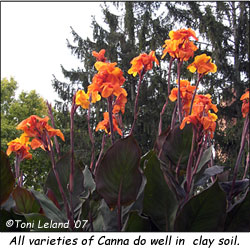
(Editor's Note: This article was originally published on April 28, 2008)
Learning to work with this native soil is the secret to nurturing many beautiful plants, shrubs, and trees. Familiar clay-loving plants include black-eyed susans (Rudbeckia), cannas, joe pye weed (Eupatorium), purple coneflower (Echinacea purpurea) and sunflower (Helianthus), to name a few.
Of all the soil types, clay has the most minute mineral components; when wet, clay is slippery and slow to drain; when baked in the sun, clay becomes hard and unworkable. Clay is the last soil to warm in the spring.
On the positive side, clay has high levels of nutrients and will support many more specimens than one might think.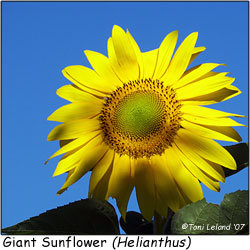
Preparing the planting site and maintaining hydration are the key steps in enjoying a satisfying relationship with clay. Plan your planting for spring when the soil is most workable; be sure to wait until ground temperatures warm up and excess moisture has drained, otherwise you'll end up with clumps and clods. With clay beds, unless you love to till and dig, it is not necessary to cultivate the entire planting area. Decide where your plants will be located, then dig individual holes and amend them with peat or other organic soil amendments. (Pay close attention to the nutrition requirements of the plant; some will not appreciate over-fertilization.) Dig the planting hole much larger than usual to accommodate the amendment and give the new plant some room to establish itself before being required to burrow its roots into the surrounding resistant soil.
When you dig the hole, take a moment to inspect the sides. Note the slick shiny surface you've created. This surface will not allow water to leave or enter the planting hole. The answer? Using a hand-cultivator with 3 or 4 tines, drag it from the bottom of the hole up the sides to form little furrows all the way around. These breaks in the slick surface will allow drainage and absorption.
Maintaining moisture during dry periods is critical; do not allow the top 3 inches of soil to dry out. Mulch is the obvious answer to this management issue. Spread mulch no more than 2 to 2-1/2 inches deep and soak it thoroughly. Ideally, mulch should cover all the planting area to prevent wicking and evaporation. Be sure to keep mulch material well away from the stem or trunk, since the decomposition process produces heat and can cause plant damage. (For more information, refer to my article on Mulch.)
Remember, any new planting - whether it is drought tolerant or simply not fussy - will need TLC for the first season. From then on, you can relax and enjoy the fruits of your labor. So, gardeners take heart. The following partial list of clay-tolerant plants will enrich your landscape, giving you depth and color without many complaints.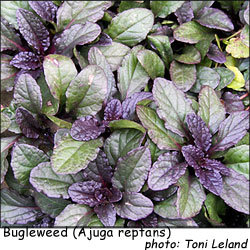
Aster (Symphyotrichum spp.)
Astilbe (Astilbe spp.)
Bee Balm (Monarda)
Black-eyed Susan (Rudbeckia)
Bugleweed (Ajuga reptans)
Butterfly Bush (Buddleja davidii)
Columbine (Aquilegia spp.)
Coreopsis (Coreopsis spp.)
Creeping Phlox (Phlox subulata)
False Indigo (Baptisia)
Gaura (Gaura spp.)
Gayfeather (Liatris spp.)
Goatsbeard (Aruncus aethusifolius)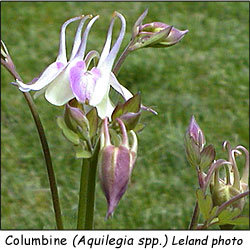
Hosta (Hosta spp.)
Joe Pye Weed (Eupatorium)
Lantana (Lantana spp.)
Canna Lily (Canna spp.)
Daffodil (Narcissus)
Daylily (Hemerocallis)
Milkweed (Asclepias tuberosa)
Miscanthus (Miscanthus sinesis)
Rugose Rose (Rosa rugosa)
Obedient Plant (Physostegia virginiana)
Oxeye Daisy (Heliopsis)
Purple Coneflower (Echinacea purpurea)
Salvia (Salvia spp.)
Shasta Daisy (Leucanthemum x superbum)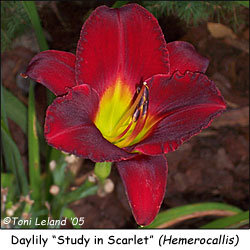
Sunflower (Helianthus)
Beautyberry (Callicarpa dichotoma)
Burning Bush (Euonymus alatus)
Chokeberry (Aronia melanocarpa)
Deutzia (Deutzia gracilis)
Flowering Quince (Chaenomeles japonica)
Forsythia (Forsythia spp.)
Japanese Barberry (Berberis thunbergii)
Lilac (Syringa vulgaris)
Ninebark (Physocarpus opulifolius)
Potentilla (Potentilla fruticosa)
Red Osier Dogwood (Cornus sericea)
Spirea (Spiraea spp.)
Swamp Hibiscus (Hibiscus coccineus)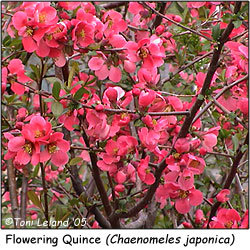
Viburnum Arrowwood (Virburnum dentatum)
Winterberry (Ilex verticillata)
Witch Hazel (Hamamelis vernalis)
Ash (Fraxinus spp.)
'Bradford' Flowering Pear (Pyrus calleryana 'Bradford')
Eastern redbud (Cercis canadensis)
Flowering crabapple (Malus)
Maple (Acer spp.)
Oak (Quercus spp.)
River Birch (Betula nigra)
Willow (Salix spp.)
Copyright © www.100flowers.win Botanic Garden All Rights Reserved